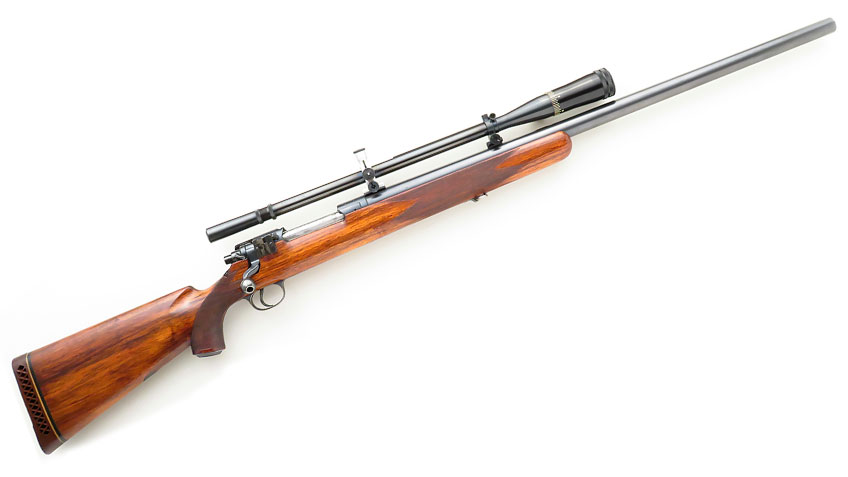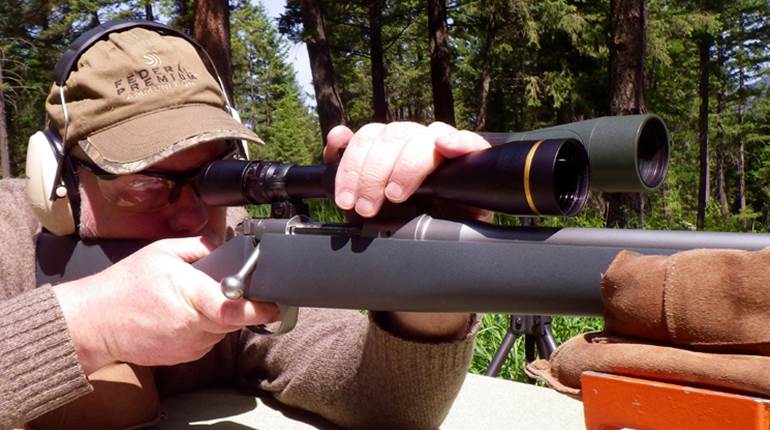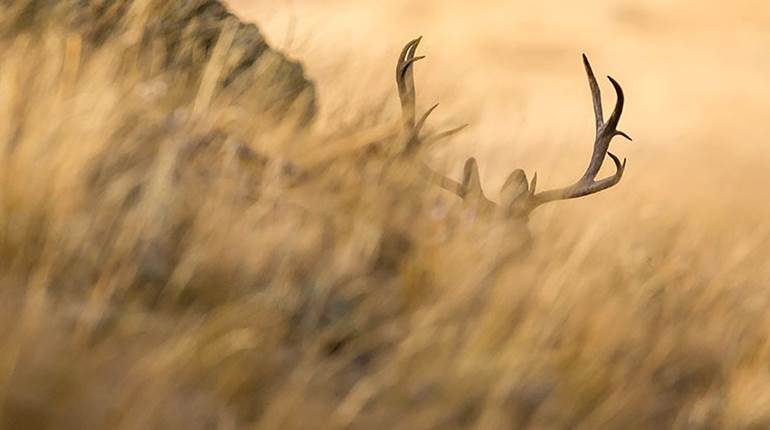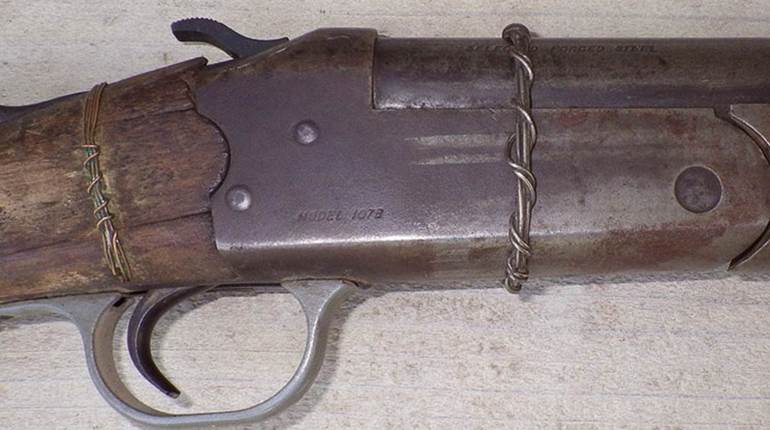

One of the most exciting things for a firearm dealer is stumbling into something historic. As it is with trophy hunting, success happens infrequently, but when a special item presents itself the initial enthusiasm and sense of accomplishment following the acquisition is unmatched. Having a hand in returning that grandest of finds to the family that has been searching for a lifetime for it is beyond description.

“This is Carolyn Comfort,” the friendly voice began. “I’m calling about … .”
“I know why you are calling!” I interrupted, manners having taken immediate leave.
Some weeks prior, with nothing better to do than contemplate what assembly of critters might have set up housekeeping in my expanding gray beard, I had discovered a wonderful Griffin & Howe single-shot “bull gun” in .300 Holland & Holland Magnum.
That “Ben C. Comfort, 1935 Winner, The Wimbledon Cup Match, Camp Perry, Ohio, Score-100-14V” was engraved along the stout barrel set a barbed hook. I was waiting in the driveway when the UPS truck stopped to make the delivery, and a flurry of research was quick to begin.
Those who have attempted such things know well that gaps in factory records present themselves with alarming frequency. When it comes to Griffin & Howe’s creations, that gap is a 40-year chasm spanning the time this rifle was finished.
Built on a Remington 30-S Express action with a serial number that dates it to 1932 per Remington, Griffin & Howe rifle No. 1415 was “likely” completed in 1935, according to G&H Archivist Bob Beach. Sadly, that was all the information Beach was able to offer after multiple diligent searches.

According to the chapter “Ben Comfort’s Sighters” in The National Matches—1903-2003, The First 100 Years published by the NRA’s Competitive Shooting Division (NRA was, of course, the sponsor of Camp Perry’s Wimbledon Cup), Comfort had “[O]nly just received his custom-built rifle. He had no sighting data for 1,000 yards.”
The passage supported the G&H archivist’s assertion that the rifle was made and shipped in 1935. This same chapter states that Griffin & Howe indeed built Comfort’s rifle on an M1917 action, the Remington 30-S being visually similar to a M1917 without the rear sight “ears,” and that it was stocked by G&H’s Ernest Kerner.
The chapter also cites a 1936 Griffin & Howe ad, which stated that the barrel was 30" long and tapered from a diameter of 1.3" at the receiver to 1.0" at the muzzle. The barrel of this rifle was, indeed, 30” long and measured 1.241" at the receiver and 0.941" at the muzzle, the slight difference a likely result of finishing. It also reports that Comfort’s rifle was a single-shot, as was the one in my possession (the magazine box was plugged with a carefully fitted walnut insert).
I had also discovered a Griffin & Howe ad in the November 1935 issue of The American Rifleman that read, in part, “Camp Perry Wimbledon Cup won this year by Ben C. Comfort with a Griffin & Howe .300 Magnum rifle.” Another G&H ad from the September 1936 issue confirmed that the Comfort rifle was stocked by the company’s own Ernest Kerner.
A dedicated search effort by helpful friends at NRA Headquarters, most notably that of American Rifleman’s Mark Keefe and NRA National Firearms Museum Senior Curator Phil Schreier, failed to turn up any specific reference to Comfort’s rifle by serial number. Unfortunately, all the records kept of Wimbledon Cup competition rifle trigger pull weights by year and serial number were cast out long ago.
To my mind, the single most amazing part of the rifle’s history is its direct connection to Elmer Keith. In Keith, An Autobiography, Elmer Keith writes, “In 1933 I booked Ben Comfort and Vic Asby from St. Louis for a month’s sheep, goat and deer hunt in the Big Horn Craig’s.”
Then, after relating some happenings of the hunt, Keith remembered, “While Vic and Gerry were off on a side hunt down Roaring Creek, we got a three-day blizzard. While Ben and I were waiting it out, he asked me what it would take to win the Wimbledon cup. I told him the best cartridge I knew would be the .300 Magnum bull gun, and he had Griffin & Howe build it … The next year at Camp Perry, he won the great Wimbledon cup and sent me a picture of himself drinking beer out of it. He was a big, fat man, and I surely enjoyed the picture of him drinking beer out of that huge Wimbledon cup. After that, it was a long time before the cup was won with anything but the .300 Magnum.”
Elsewhere, Keith recalls his response to Comfort’s questioning about the ideal rifle Wimbledon Cup rifle, “a .300 Magnum bull gun with a 30-inch barrel, prone stock,” then “Ben had Griffin & Howe make it up, and the shooting world knows what he did with it.” Finally, Elmer related that he “saw the finest mule deer of his entire life on that trip,” and that Comfort missed it three times at 400 yds. He had even offered Comfort $100 for the opportunity to take the shot, but Ben turned him down.
In addition to the Wimbledon Cup engraving, the rifle is also marked “No. 1415 Griffin & Howe Inc. New York”, this on the center of the barrel. The bolt body, extractor and rail are wonderfully jeweled, and the stock features a bold cheekpiece with shadow line, metal pistol grip cap, blank oval in the toe line and an inletted base with a loop for a shooting sling is positioned up front. Sans scope, the rifle weighs 13 lbs., 3 ozs., and has a length of pull of 13.6".
As received, the rifle was topped with a Lyman 10X Super Targetspot No. 6439 with straight “cross hair” reticle and threaded metal lens caps. Surprisingly, its lenses remained nearly pristine, and optical quality is without issue. It is worth noting that this scope differs from that which Comfort used in 1935, but this is something one can easily forgive.

The rifle’s condition is exceptional. The bore is strong and bright, with sharp rifling. Rust blue is about 95 percent overall, with evidence of open sights which are now absent. The rear bridge was drilled and tapped with two open holes, a third carefully filled.
Wood condition remains about 85 percent, with a very good finish and a number of modest field and handling impressions. The stock also has what appears to be an original splice to the rear of the pistol grip, this adding a bit more wood so as to give it additional depth. For all that, both checkering and finish over this area appear to be original.
Along with the rifle came the October 1935 issue of The American Rifleman, plus photocopies of “Ben Comfort’s Sighters” and Elmer Keith book pages. Also included were articles on Comfort, the Wimbledon Cup, the influence of Comfort’s win on long-range shooting and the acceptance of magnum cartridges in the hunting world. Clearly, someone had walked down the research trail ahead of me.
Another interesting, but still unverified, aspect of the research strongly suggests that Comfort had Griffin & Howe build a pair of rifles for his effort.
Carolyn Comfort and I visited for a very long time during that initial call. Her husband, and Ben’s grandson, Mike, had been searching for the rifle for some 35 years. Both had recently retired from their respective military service careers, and Mike was actually researching loading data when he came upon the link to my listing of the rifle.
“Mike was so nervous, he asked me to make the call. Of course, we want the rifle,” Carolyn quickly added.
Rather than ship the rifle, the Comforts made a vacation out of picking it up, driving from the deep South to Montana. For their arrival I had the rifle and all the supporting documents properly displayed and was surprised how long it took for Mike to stop staring and, with the greatest of care, eventually lift it from the cradle.
After a bit, we drove to a nearby private shooting range where Mike, Carolyn and I each took a shot in turn. I hadn’t secured the scope more than finger tight, and our three-shot, 100-yd. “group” came in at about 1".

Even though Mike has but faint memories of his grandfather, the rifle will rightfully become a family heirloom. At some point, it will pass to James Comfort, Mike and Carolyn’s son.
The Comforts were heading to “The Well Armed Woman” leadership conference on their way home, and promised to show and share the rifle with other attendees who were interested. I imagine more than a few took them up on their offer, as will certainly be the case if the rifle is one day displayed during the Wimbledon Cup.
NRA Life member Dwight Van Brunt owns Sportsman’s Legacy (sportsmanslegacy.com), a firm specializing in the purchase and sale of fine firearms and sporting collectibles.






































